
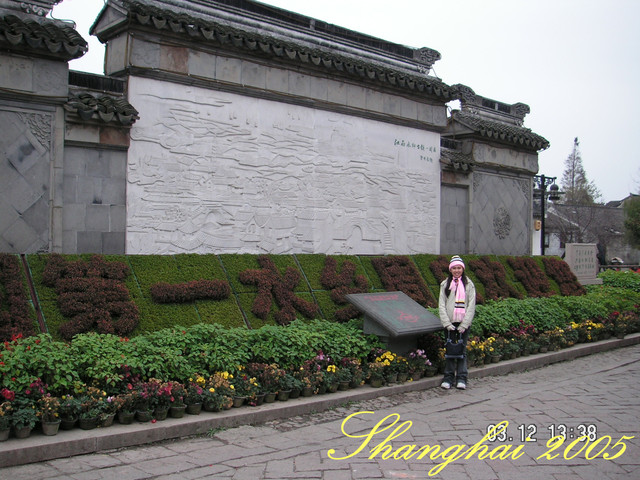
Main Gate of Zhouzhuang
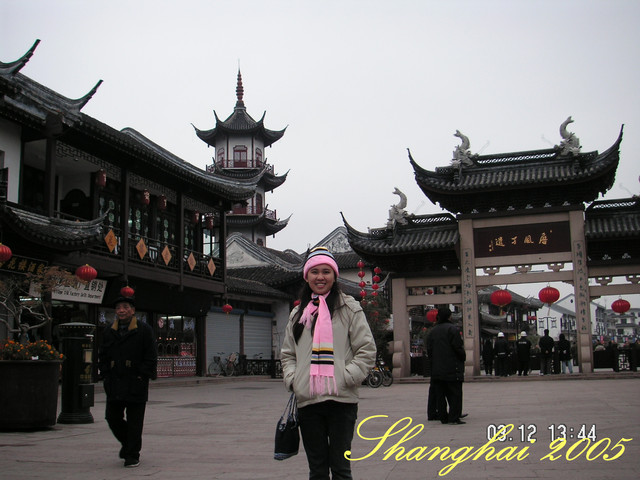
Zhouzhuang was pretty much like Tongli, although I did feel the two towns were a little more commercialized that I thought.
It was a pity, as the heritage sites should be preserved its originality. On the other hand, these locals do need to earn a living as well, don't they?
I will take it that it is their pride =)
I did not have much photos of Zhouzhuang; mainly because of, 1) the weather was getting cold, 2) The camera's batteries died 3)most of the buildings and canals were just like Tongli
Like Tongli, Zhouzhuang were also lined with intersections of bridges over the canals
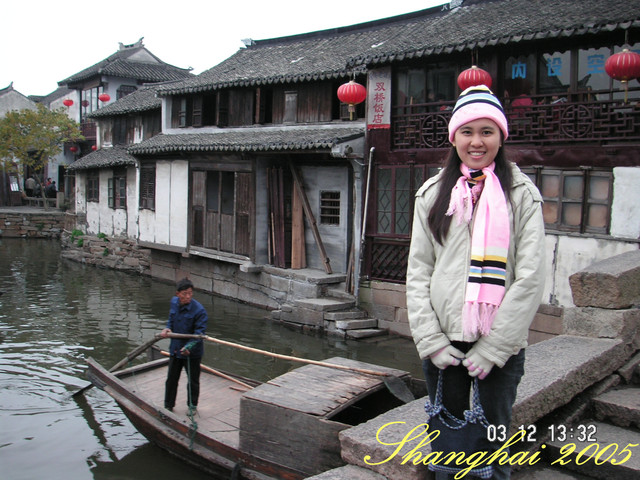
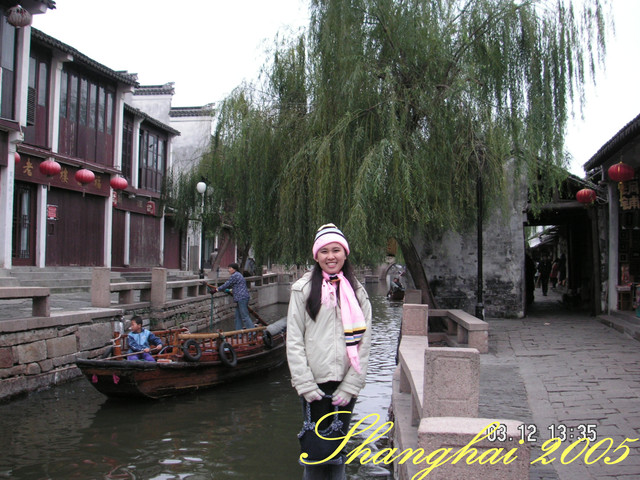
However, there are also a few notable attractions; mostly the bridges and two mansions.
1. Twin Bridges (Shuang Qiao)
Quoted from Travel China Guide
Zhouzhuang is surrounded and divided by lakes and rivers, 14 stone bridges cross the rivers, showing distinctive views of the water-town. Twin Bridges which comprise Shide Bridge and Yongan Bridge are the most famous and is considered the symbol of Zhouzhuang. Built in Wanli era (1573 - 1619) of the Ming Dynasty, Twin Bridges is in the northeast of the town. Shide Bridge is east-west and has a round arch, while Yongan Bridge is north-south and the bridge arch is square. Crossing the two crisscross rivers (Yinzi Creek and Nabeishi River) and connecting at the middle, Twin Bridges look like a Chinese old-style Chinese key. In 1984, 38 canvases of the notable painter, Chen Yifei, were exhibited in a New York gallery of Armand Hammer, chairman of Occidental Petroleum Corporation. 'Memory of Hometown' which depicts Twin Bridges was one of the items on display and has gained the world's attention for Zhouzhuang. The painting was chosen to be the first-day cover of the United Nations' postage stamp in 1985.
2. Fu An Bridge (translated as Fortune and Peace Bridge)
From China Highlights
Fu'an Bridge is located at the east end of Zhongshi Street, crossing the Nanbeishi River and leading to Nanbeishi Street.
It was built in 1355, and later rebuilt by Shen Wansi, younger brother of Shen Wansan. There are towers on all four corners. Each side has carved beams and painted rafters. People can now enjoy local foods and shopping in the towers.
3. ZhenFeng Bridge
From China Highlights
Zhenfeng Bridge sits on the west mouth of the Zhongshi River, and connects the Zhenfeng Lane and Xiwan Street. It was built in the Ming and Qing Dynasties, and is well preserved today.
Zhouzhuang has about 1000 households who are living in the old dwelling quarters built in the Ming, Qing dynasties and the early Republic of China. More than 60% of these houses are well preserved. There are 100 houses with courtyards and 60 of these have arch gateways made by carved bricks. The houses of both Zhang and Shen families have remained intact and serve as excellent examples of traditional Chinese architecture
Houses/Mansions
4. Shen House
From China Highlights
Shen's House is located to the southeast of Fu'an Bridge, on Nanshi Street. Shen Benren built it in 1742 during the Qing Dynasty. He was a descendant of Shen Wanshen: a wealthy man in southern China in the late Yuan (1206-1368) to early Ming Dynasties.
The compound has seven courtyards, five archways and more than 100 rooms of different sizes. Covering an area of 2000 square meters, it was built along both sides of a 100-m-long axis.
There are three sections. The first section includes the water gate and wharf for mooring boats and washing. The second section consists of the Tea Hall and Main Hall for receiving guests and holding weddings or funerals. The rear part serves as living quarters.
The Main Hall covers 170 square meters. The 6-m-high carved brick archway, facing the Main Hall, has a horizontal board bearing the inscription Jihouliuguang (do more good forever). Around the board are relief sculptures of figurines, animals, pavilions and opera characters.
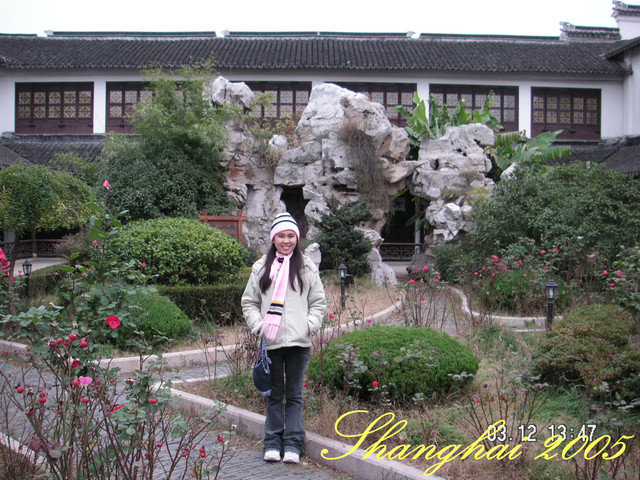

5. Zhang House
From China Highlights
Zhang's House is located to the south of the Twin Bridge on Beishi Street. It was built between 1436 and 1449 by the offspring of Xu Kui, the brother of Zhongshan King Xu Da. After it was sold to the Zhang family in the early Qing Dynasty, it became known as either Yuyan (Jade Swallow) Hall or Zhang's House.
Covering more than 1800 square meters, the house has 6 courtyards and more than 70 rooms. The main courtyard has buildings facing east and west, with long and short windows. Yuyan Hall is the main building. The hall is large and bright with grand columns on large pier bases, a rare Ming style. A river flows under the hall. A square pool built in the middle section allows boats to turn round. Its rear hall has open windows and balconies facing the water with a backyard of various plants and flowers.
The place is now an important cultural relic under the protection of the provincial government.
6. Ye Chuchang Residence
From China Highlights
Born in Zhouzhuang, Ye Chucang (1887-1946) was a poet and a statesman. He was a graduate of Suzhou High School. When he came home during one winter vacation, he saw the destructive effects of gambling and opium on the population. He was credited with organizing a group of young people to publicize and steer people away from these harmful activities.
His residence, Zuyin Hall, located on Xiwan Street facing north, was built in the Qing Dynasty and has five courtyards. The Main Hall was his studio and the Rear Hall was a place where he received friends.
Others include:
7. Milou Tower
8. Chengxu Taoist Temple
Overall, Zhouzhuang was another miniature version of Venice with her own story.

It is the commonality which made this town on the list of China or rather Suzhou's Four prominent water villages; following the sakes of Tongli, Xitang and Wuzhen.
Too bad the weather was too cold; but I truly did enjoy my short tours to these water villages before heading back to the city.
That wraps up my tour of Shanghai back in 2005 when I was traveling on business purpose.
I do hope to go back some day; and I will definitely make my trips to all the water villages, with more photos of all the attractions this time ;)
Goodbye to Shanghai....


No comments:
Post a Comment